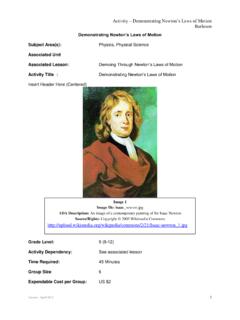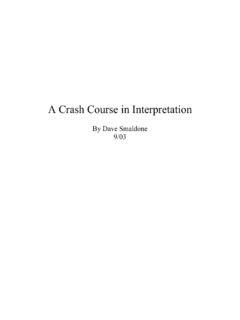Transcription of Lesson 1: Trash: It Lasts a Long Time!
1 City of Tucson recycling Education ProgramPage 10 Lesson 1 Talking trash in Tucson: A Middle School Curriculum on RecyclingLesson 1: trash : It Lasts a long Time! At a Glance:Students complete a worksheet while participating in a class discussion about Tucson s Los Reales landfill and the practices of municipal solid waste management utilized in town. In the activity section of this Lesson , students work in small groups to estimate and come to consensus agreement on the length of time it takes specific materi-als to decompose in a landfill. After considering the alternatives to current waste disposal methods such as reduc-ing, reusing and recycling , students describe their concluding thoughts about waste management practices in our Department of Education Academic Standards:Please refer to the Arizona Department of Education Academic Standards section for the ADE standards addressed by this Objectives:Students will be able to.
2 * understand the limitations of sending municipal waste to a landfill* formulate their best estimate of how long some trash items might last in a landfill * work together in a group to come to consensus* understand some of the processes and environmental consequences of waste disposal* draw conclusions that will direct their personal choices about consumption and waste disposal* develop and express an opinion on solid waste managementTrash Talk: Key Wordssolid waste management, landfill, decomposition, biodegrade, longevity, trash , garbage, compost, reduce, reuse, recycleMaterials:o Student Worksheet: How long Does trash Last? photocopy one per student o Overhead Transparency: Los Reales Landfill, Tucson, Arizona o Overhead Transparency: trash Decomposition Timeso Overhead Transparency: Garbage Longevityo Display Materials (Prior to class, collect the items listed below which are sometimes thrown away.)
3 The boot and sock can be still useful items from your home. Write this list of items on the board or chart paper.)(continued on next page)n aluminum can (soda pop can) n bananan cigarette buttn cotton rag n glass bottle n leather boot n paper bag n plastic 6-pack rings n plastic jug n rubber sole of a leather bootn Styrofoam cup n steel-tin can (soup or vegetable can) n wool sockCity of Tucson recycling Education ProgramPage 11 Lesson 1 Talking trash in Tucson: A Middle School Curriculum on RecyclingProcedure:Part 1: Landfills as a Solid Waste Management Option1. Direct the students attention to the display of trash items, as noted in the Display Materials list. Tell students that these items are examples of what is termed solid waste . Explain that every town or city must have procedures to handle solid waste.
4 In Tucson, solid waste is managed by the City of Tucson s Environmental Services. Ask students to name other items from home or school that may flow into the Tucson solid waste stream . Their suggestions may include any item that is thrown away or Hand out the student worksheet, How long Does trash Last? Have students complete the student and class information at the top of the page and write responses for question 1: List some procedures that your community uses for management of solid waste. When this has been completed, ask students to share some of their comments. Lead the students to understand that the City of Tucson Environmental Services provides city-wide recycling collection and operates the Los Reales Display the overhead transparency, Los Reales Landfill, Tucson, AZ, a page of images and information about the Los Reales Landfill site in the southern part of Tucson.
5 Ask students if any of them have ever been to this landfill. Read aloud the text shown on the overhead. Encourage students to express their opinions about landfills, trash and waste management by responding to question 2 on their worksheet: Describe your impressions of a landfill site. Ask and discuss the question, How can we help make landfill space last longer?4. Tell students that the materials you have collected are samples of items which are sometimes tossed away and end up in a landfill such as Los Reales. Have students respond to the worksheet questions num-bers 3-7: n 3. What do all the items in the class trash collection have in common? n 4. What will happen to these items if they end up in the landfill? n 5. Which item do you think will take the shortest time to decompose? n 6. Will all the items disappear/disintegrate/degrade immediately or will they continue to take up space in the landfill?
6 N 7. Which items, if any, will never decompose?5. You may wish to let students quietly discuss those questions with each other. After students have all completed their responses to the questions, discuss them as a Next, draw students' attention to question 8 on their worksheet, a table including the list of trash items in the collection of materials. Instruct students to:n Think on their own about how long each of the items on the list might last when buried in a landfill. n Write in the first column their own best guess , as a range, for how long each item might take to completely Point out to students that there is not necessarily a right answer because various conditions could result in some items degrading more or less quickly. If time permits, ask students to name some things that could effect decomposition time , such as weather or the amount of moisture or heat inside the landfill.
7 (continued on next page) Lesson 1: trash : It Lasts a long time ! (continued)City of Tucson recycling Education ProgramPage 12 Lesson 1 Talking trash in Tucson: A Middle School Curriculum on RecyclingProcedure: (continued)8. When all students have recorded their own best guesses , arrange students into small groups of 3 to 4 students. Display the overhead transparency, trash Decomposition Times. Tell each group to use the times displayed on the overhead and come to a consensus agreement about their best guess of the decomposi-tion time of each of the items. Students should record these times in column 3. In the fourth column, have students record the numbers 1-13 to correctly sequence the list in order from shortest to longest decompo-sition time . As groups finish this task, have them talk among themselves about the process of consensus and how best to present their group s Ask the groups to share their lists in the sequence they agreed upon.
8 Call on a member of the group to provide the item and the decomposition sequential number. Record this number next to the appropriate word on the board or chart in front of the class. For example, if they call out "sheet of paper -- number 1," write the number 1 after that phrase. Do the same for the other groups. When that activity is completed, draw students' attention to the discrepancies in the list. For example, Why did some groups choose to list the sheet of paper before the banana? At the conclusion of the discussion, reveal to students the best esti-mates of scientists, who say the following is the most probable sequence: 1. banana 8. tin can (soup or vegetable can)2. paper bag 9. aluminum can (soda pop can)3. cotton rag 10. plastic 6-pack rings4. wool sock 11. plastic jug5. cigarette butt 12. Styrofoam cup6.
9 Leather boot 13. glass bottle7. rubber sole of a boot10. Next, display the overhead of the scientists' approximations listed below: n banana -- 3 to 4 weeks n paper bag -- 1 month n cotton rag -- 5 months n wool sock -- 1 year n cigarette butt -- 2 to 5 years n leather boot -- 40 to 50 years n rubber sole (of a boot) -- 50 to 80 years n tin can (soup or vegetable can) -- 80 to 100 years n aluminum can (soda pop can) -- 200 to 500 years n plastic 6-pack rings -- 450 years n plastic jug -- 1 million years n Styrofoam cup -- unknown? forever? n glass bottle -- unknown? forever? Sources: and (continued on next page) Lesson 1: trash : It Lasts a long time ! (continued)City of Tucson recycling Education ProgramPage 13 Lesson 1 Talking trash in Tucson: A Middle School Curriculum on RecyclingProcedure: (continued)11.
10 After you have provided students with data about the longevity of the trash items on display, refer students to the last column of the chart for question 8 on their worksheet. Instruct students to record the scientists estimations in this column. 12. Ask students to share their thoughts as to why they feel their sequence may not agree with the scientists list. Point out that it is acceptable for scientists to have different conclusions if these are support-ed by good evidence. Read aloud from the overhead transparency, Garbage Longevity, the short summary regarding the research of William 2: Options for Waste Management Reduce, Reuse, Recycle1. Review the ideas generated in the previous activity regarding trash decomposition time . Discuss the following questions: n What does the data (the scientists approximations of decomposition time ) tell you about landfills?





